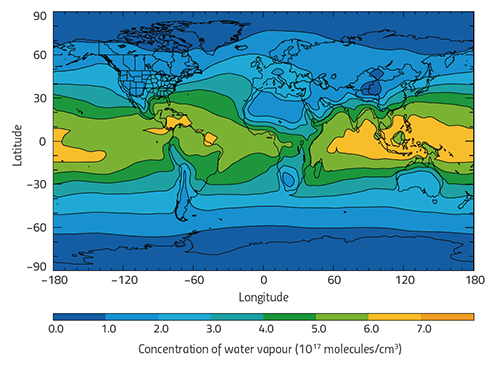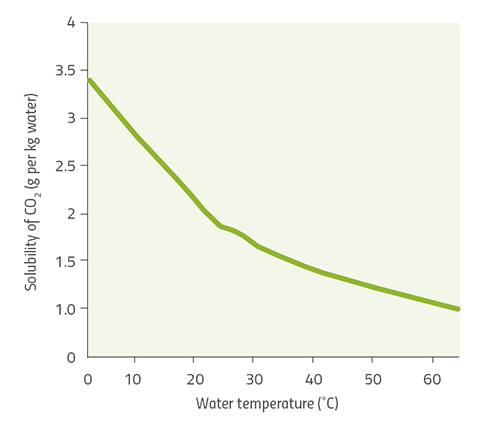Climate change: why the oceans matter Understand article
The role of our oceans in climate change is more complicated than you might think.

image source: Flickr
The world’s oceans are truly vast, covering 71% of Earth’s surface and containing 97% of Earth’s water. If we are concerned about factors that affect the global climate, we need to look at the oceans as well.
As with most areas of climate change (that is, a change in the average surface temperature of Earth), the role that oceans play is complex. The main factors involved are ocean-generated compounds (including water vapour) escaping into the atmosphere; carbon dioxide dissolving in sea water; and the role of the oceans as a heat sink.
Water vapour: warming or cooling?
When we think about gases involved in climate change, we generally think of carbon dioxide and perhaps some other gases in the atmosphere such as methane. These gases contribute to the greenhouse effect by absorbing and trapping infrared energy (heat) from Earth’s surface. In fact, the most potent greenhouse gas in the atmosphere is not any of these, but simply H2O in the form of water vapour (figure 1).
Water vapour in the atmosphere absorbs 36–85% of Earth’s outgoing infrared energy, compared with the much lower figures of 9–26% absorbed by carbon dioxide (CO2) and 4–9% by methane (CH4). The main source of atmospheric water vapour is evaporation from the oceans.
Although water vapour has a large effect on how much heat our planet retains, it has an impact on climate only because of the warming effect of other greenhouse gases such as CO2 and CH4. If there were no such greenhouse gases in the atmosphere, the average surface temperature of Earth would be much colder – around -18 °C – and very little water would evaporate into the atmosphere. The presence of greenhouse gases in the atmosphere increases the surface temperature of Earth, which leads to water evaporating. This in turn increases warming further, due to the greenhouse effect of water vapour, and so on. This ‘vicious cycle’, where different factors exacerbate each other, is called a positive feedback loop.
But water vapour also has a reverse effect: more water vapour in the air means more clouds. Clouds reflect much of the incoming sunlight back into space, producing a cooling effect that moves the global climate in the opposite direction to the greenhouse effect. At present, the net effect of clouds is to cool Earth’s surface by about 5°C, but we do not know which of these two competing factors – the warming or cooling effect of water vapour – would dominate in a warmer climate.

Image courtesy of RG Derwent, RD Scientific, UK
Other ocean compounds
In addition to water vapour, the oceans release other compounds into the atmosphere that contribute to climate change. Some compounds that escape from the oceans create tiny particles in the atmosphere, which act as cloud seeds, allowing water vapour to condense and form clouds.
One of the most important cloud-seeding compounds in the atmosphere is dimethyl sulfide (CH3SCH3), a sulfur compound produced by phytoplankton (plant-like plankton) in the oceans. It evaporates easily into the atmosphere, where it oxidises to form sulfur dioxide (SO2) and methane sulfonic acid (MSA). The sulfur dioxide combines with water in the atmosphere to form sulfuric acid, yielding sulfate ions, SO42-. These and the MSA are very effective seeding agents, allowing water vapour to condense into droplets, leading to cloud formation.
Another group of compounds that enter the atmosphere from the oceans are the organohalogens – for example methyl chloride (CH3Cl). Like their synthetic counterparts (for example, chlorofluorocarbons, or CFCs), organohalogens promote the breakdown of ozone in the stratosphere by taking part in photochemical reactions with ozone. Ozone has an important role in absorbing incoming solar radiation and helping to protect us against UV light, but it is also a potent greenhouse gas – and, like carbon dioxide, is produced by human activity. In fact, the increase in ozone levels since the introduction of industrialisation over the past 200 years is responsible for some 15% of the entire anthropogenic (human-caused) greenhouse effect. Ocean-generated organohalogen compounds thus contribute to a reduction in global warming by reducing the concentration of ozone in the atmosphere.
Dissolved CO2: the runaway greenhouse effect
The oceans also have a vital role in absorbing CO2. Carbon dioxide released by the burning of fossil fuels and other human activities as well as from the biosphere is absorbed either in the atmosphere or in the oceans. Although Earth’s atmosphere contains some 3 trillion (3 × 1012) tonnes of carbon dioxide, about 50 times more CO2 is present in the oceans.
At the ocean surface, carbon dioxide from the atmosphere dissolves in the water. There, it reacts with water to form carbonic acid (H2CO3), hydrogencarbonate (bicarbonate, HCO3–) and carbonate (CO32-) ions:
CO2(g) + H2O(l) → H2CO3(aq)
H2CO3(aq) ⇌ HCO3– (aq) + H+ (aq)
These reactions reduce the amount of dissolved CO2, so more CO2 is absorbed from the atmosphere.
Dissolved CO2 at the surface is then dispersed through the ocean depths by a process called the solubility pump. Because CO2 is more soluble in cold water than in warm water (figure 2), and the ocean depths are colder than the surface, CO2 is drawn away from the surface into deeper water.
If there is an increase in ocean temperature due to climate change, then more carbon dioxide will be released due to its lower solubility at higher temperatures. The extra CO2 would contribute to the greenhouse effect, increasing the ocean temperature still more and releasing yet more carbon dioxide, and so on – creating another positive feedback loop and leading potentially to a runaway greenhouse effect.

Image courtesy of Nicola Graf; data source: Handbook of Chemistry & Physics (1953), CRC
Soaking up heat
The sheer vastness of the oceans is a key factor in their role in climate change. It determines how much of the excess heat produced by global warming can be taken up by the oceans – much more in fact than by the atmosphere.
We can do a calculation to compare the temperature rise of the oceans and the atmosphere when the same amount of heat is added to both (see box). This calculation reveals that the heat capacity of the oceans is approximately 1000 times that of the atmosphere, so the oceans will show a much lower rise in temperature for the same amount of heat energy absorbed. This means that the timescales for climate change are driven primarily by the ocean’s thermal mass, not by that of the atmosphere. Of course, this doesn’t mean that temperature will not rise – but it does mean that the timescale will be much longer than has generally been assumed.
Warming the world: a calculation
We can compare how the temperature of the atmosphere and the oceans would rise if the same amount of heat energy were added to both. To keep things simple, we will use approximate figures throughout. (The heat capacity of a substance is the amount of energy needed to raise the temperature of each kilogram by one kelvin (K) – which is the same as one degree Celsius.)
Mass of Earth’s oceans
Heat capacity of seawater
Heat capacity of the oceans
= 1.3 x 1021 kg
~ 4.0 x 103 J kg-1 K-1
~ 1.3 x 4.0 x 1024
= 5.2 x 1024 J K-1
So, 5.2 x 1024 J of energy would be needed to raise the temperature of the oceans by 1 K.
Compare this with the heat capacity of the atmosphere:
Mass of Earth’s atmosphere
Heat capacity of air
Heat capacity of the atmosphere
= 5.1 x 1018 kg
~ 1.0 x 103 J kg-1 K-1
~ 5.1 x 1.0 x 1021
= 5.1 x 1021 J K-1
So, about 5 x 1021 J of energy would be needed to raise the temperature of the atmosphere by 1 K.
So we can see that the ratio:
Heat capacity of oceans / Heat capacity of atmosphere = 5.2 x 1024 / 5.1 x 1021 = ~ 1000 J K-1
This means that, at a heating rate of 1 W (1 J s-1) per square metre across Earth’s surface (about 5.1 x 108 km2), it would take about 116 days to cause a rise in temperature of 1 K (or 1 °C) in the atmosphere – but 324 years to cause the same rise in ocean temperature.
Oceans and the future
So what role do the oceans play in climate change? The answer is complex. Compounds released from the oceans can contribute both to climate heating, by acting as greenhouse gases, and to climate cooling, by increasing cloud. The oceans themselves can absorb heat energy and act as a sink for carbon dioxide – but as the water temperatures rise, a positive feedback loop can occur. As yet, the net impact of our oceans on climate change is unclear, but scientists continue to study all these systems so that as more complex models are developed, we gain a better idea of the future of our planet.
References
- IPCC (2013) Climate Change 2013: The Physical Science Basis. Cambridge, UK and New York, USA: Cambridge University Press. doi: 10.1017/CBO9781107415324
Resources
- Visit the NASA website to find out more about the effect of water vapour on climate change.
- For further calculations relating to climate change for advanced physics students, see:
- Harrison T, Shallcross D (2008) Climate change modelling in the classroom. Science in School 9: 28–33.
- For classroom experiments relating to climate change, see:
- Shallcross D, Harrison T (2008) Practical demonstrations to augment climate change lessons. Science in School 10: 46–50.
- Shallcross D, Harrison T, Henshaw S, Sellou L (2009) Fuelling interest: climate change experiments. Science in School 11: 38–43.
- To learn more about ozone in the atmosphere, see:
- Shallcross D, Harrison T (2010) A hole in the sky. Science in School 17: 46-53.
- To learn more about cloud seeding, see:
- Ranero Celius K (2010) Clouds: puzzling pieces of climate. Science in School 17: 54-59.
Review
This article provides a clear overview of the role oceans play in climate change. In particular, the article discusses the effect of compounds such as water vapour, the potential runaway greenhouse effect of dissolved CO2, and the differential heat capacity of oceans and the atmosphere.
The article can be used to link chemistry, biology and earth science, and covers topics such as the greenhouse effect and the water cycle.
Enrico Capaccio, Liceo S. Bellarmino, Italy
